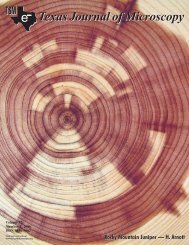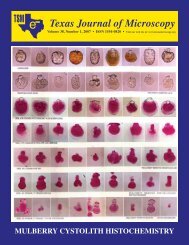Texas Journal of Microscopy - Texas Society for Microscopy
Texas Journal of Microscopy - Texas Society for Microscopy
Texas Journal of Microscopy - Texas Society for Microscopy
Create successful ePaper yourself
Turn your PDF publications into a flip-book with our unique Google optimized e-Paper software.
Figure 19. Free nuclear development<br />
<strong>of</strong> the embryo <strong>of</strong> Paeonia cali<strong>for</strong>nica.<br />
With permission from Cave, Arnott<br />
and Cook, American J. Botany 48:397-<br />
404.<br />
72 Tex. J. Micros. 37:2, 2006<br />
(Fig 19). We published<br />
o u r w o r k u s i n g<br />
photomicrographs instead<br />
<strong>of</strong> drawings. Later, after<br />
I graduated, Pr<strong>of</strong>essor<br />
M a s h a w a r i v i s i t e d<br />
Berkeley, and even after<br />
viewing our preparations,<br />
he remained, “skeptical”<br />
and continued to support<br />
his student’s view even<br />
though it was in error.<br />
At the 1958 International<br />
Botanical Meeting in<br />
M o n t r e a l , M a r i o n<br />
and I met the Russian<br />
botanists and they were<br />
very “appreciative” <strong>of</strong><br />
our support. I also met<br />
Dr. Poddubnaya-Arnoldi<br />
the Montreal meeting;<br />
later I received a major<br />
monograph (in Russian)<br />
on plant embryology<br />
written by her; I still have<br />
it. I also met Pr<strong>of</strong>essor<br />
M a s h a w a r i a t t h a t<br />
meeting; he was the author <strong>of</strong> the major book on plant embryology<br />
in English. Drs. Mashawari and Poddubnaya-Arnoldi were two <strong>of</strong><br />
the most important plant embryologists in the world. One needs<br />
say no more about how important international meetings can be<br />
to young investigators.<br />
It may be <strong>of</strong> interest to note that during my tenure in Room<br />
2054 I witnessed the founding <strong>of</strong> the “Index to Plant Chromosome<br />
Numbers. This was a scheme hatched by Marion Cave and Richie<br />
Bell, a botany pr<strong>of</strong>essor at the University <strong>of</strong> North Carolina, on an<br />
afternoon in 1955 in the third cubicle. Marion edited the “Index to<br />
Plant Chromosome Numbers” <strong>for</strong> some years after its founding.<br />
The “Index” was a way <strong>of</strong> collecting chromosome numbers from<br />
the literature making it easier to gain chromosome in<strong>for</strong>mation<br />
about specific plants. It was produced by <strong>of</strong>fset press on an annual<br />
basis; the University <strong>of</strong> North Carolina underwrote the costs.<br />
While at U.C. Berkeley I sometimes helped Foster with<br />
microtechnique. For example, I helped clear the leaves <strong>of</strong><br />
Circaeaster agrestis (Circaesteraceae; Ranunculales) and worked<br />
with him when he mounted them. Circaeaster is one <strong>of</strong> a few<br />
flowering plants that have leaves with open dichotomous venation.<br />
As specimens <strong>of</strong> Circaeaster, were quite rare, they were handled<br />
with “great care.” The leaves were not very large so they were easy<br />
to manipulate in the clearing process.<br />
However, the level <strong>of</strong> technique difficulty was upgraded when it<br />
came to handling the leaves <strong>of</strong> Kingdonia uniflora. This pant, first<br />
collected in China by Kingdon Ward, was a second herbaceous<br />
flowering plant that had leaves with open dichotomous venation,<br />
a la Ginkgo, that Foster studied. The first specimen <strong>of</strong> Kingdonia<br />
that Foster got came from the type specimen contained in the<br />
Royal Botanical Garden in Edinburgh. Later Dr. Foster received<br />
additional material was received from China.<br />
Clearing the entire leaf <strong>of</strong> Kingdonia was problematic because<br />
the leaves were much larger, almost 6 cm in width. Kingdonia is<br />
a relatively delicate herb with fragile leaves. The clearing process<br />
took place in Foster’s lab/<strong>of</strong>fice and took several days. During the<br />
clearing process, especially when in chloral hydrate, the leaves<br />
were exceedingly fragile. Once the leaves were stained and<br />
dehydrated the leaves were less fragile. We devised a method <strong>of</strong><br />
Figure 20. Drawing <strong>of</strong> a cleared leaf <strong>of</strong> Kingdonia uniflora (Kingdoniaceae;<br />
Ranunculales) with open dichotomous venation. With permission<br />
from Foster and Arnott, 1960, Amer. J. Bot. 47:684-698.<br />
moving the leaves from one dish to another using a piece <strong>of</strong> glass.<br />
We also moved the leaves this was when they were so permanently<br />
mounted in piccolite (a resin). I had previously cleared large Ginkgo<br />
leaves and mounted them but they were not fragile. I used pieces<br />
<strong>of</strong> window glass <strong>for</strong> mounting ginkgo. We planned to mount<br />
Kingdonia the same way, but you could not lift the leaf with <strong>for</strong>ceps.<br />
So we used a window glass and fine brushes to slide the leaf from<br />
the large glass Petri dish onto the mounting glass. A second piece<br />
<strong>of</strong> glass was used as a coverslip. With luck, a perfect specimen was<br />
made. Believe me, there was no one more particular than Foster,<br />
when it came to microtechnique! Later, I embedded and sectioned<br />
some <strong>of</strong> this precious material and we used my sections to work<br />
out the vasculature <strong>of</strong> the petiole and lamina-petiole junction. The<br />
cleared leaf was drawn by Emily Reid who <strong>of</strong>ten made drawings <strong>for</strong><br />
Foster (Fig. 20). The photomicrographs <strong>for</strong> that paper, and many <strong>of</strong><br />
those in my dissertation, were taken by Mr. Victor Duran, a master<br />
photographer working in U.C. Berkeley Library. We published<br />
the Kingdonia paper in American <strong>Journal</strong> <strong>of</strong> Botany in 1960. Of<br />
course it was fun working with Foster but he was so intense it was<br />
also sometimes disconcerting. In his middle life Foster took piano<br />
lessons; he played the piano in the evening to relax.<br />
It is now almost 50 years since my dissertation was written. The<br />
original manuscript was written by hand and a rough copy typed<br />
by me. Jean typed the final copy; I remember how hard it was <strong>for</strong><br />
her to type my dissertation since an original and three carbon<br />
copies were required <strong>for</strong> the library inspection. The library had to<br />
sign <strong>of</strong>f on all degrees involving theses or dissertations. In 1958<br />
it was be<strong>for</strong>e liquid paper and other correction methods had been<br />
invented; long be<strong>for</strong>e IBM correcting typewriters and current word<br />
processors were available. Correcting errors, when erasing didn’t<br />
work, <strong>of</strong>ten required retyping the entire page and hoping that the<br />
changes would not disturb the overall page sequence. Today the<br />
word processing programs and digital images take all <strong>of</strong> that kind<br />
<strong>of</strong> drudgery out <strong>of</strong> writing.<br />
Some <strong>of</strong> the remaining parts <strong>of</strong> this paper will survey the<br />
unpublished research completed as part <strong>of</strong> my dissertation. As<br />
stated earlier, there was a large percentage which was never<br />
published. A series <strong>of</strong> papers could have been written from the<br />
remaining materials. Lost chances! Chances misplaced by the<br />
pressures <strong>of</strong> moving, starting a new job and, most <strong>of</strong> all, the<br />
attraction <strong>of</strong> new research. I am sure some <strong>of</strong> you are thinking,<br />
Autobiography continued on page 74




